|
Homelite Company During World War Two
Port Chester, NY
1921-Current
This page added 12-14-2023.
Homelite's most well-known
product is the chainsaw. However, the company, which began in
1921, did not get into the chainsaw business until after World War Two.
The company was originally formed to provide portable electric
generators to persons in rural areas who were without electrical utility
service.
The readers of this page
who own a Homelite chainsaw or another of its yard care products are
most likely unaware of the company's importance to winning World War
Two. I own a Homelite chainsaw but was unaware of the company's
significant contribution to the war effort until I researched the
products it produced.
Both the United States
Army Air Forces (USAAF) and United States Army Ordnance picked the
Homelite Company to provide auxiliary power units (APU) for their most
important weapons. Homelite APUs were installed in USAAF B-17s and
B-24 heavy bombers. The complete line of Army Ordnance M4 Sherman
tanks was equipped with Homelite auxiliary power units. These two
aircraft and the medium tans are three of the American military's most
iconic World War Two weapons. Homelite generators were used on a
worldwide basis and participated in all of the most important air and
ground battles of World War Two. The Homelite Company was a very
busy place during World War Two, keeping these and other weapons
supplied with its auxiliary power units.
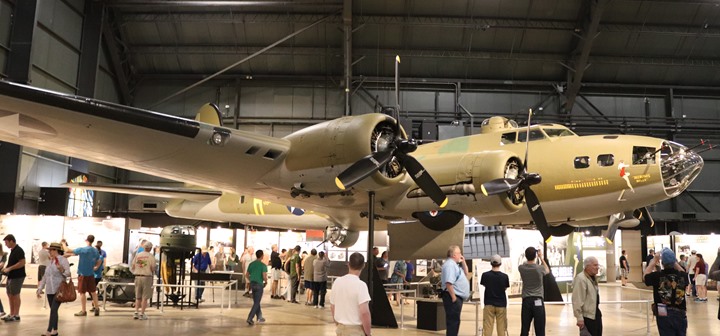
The Boeing B-17 Flying Fortress is the most
well known of the World War Two four-engine bombers due to its extensive
use in the bombing of the Third Reich. Its fame was cemented by
such post-World War Two movies as "Twelve O'Clock High"
starring Gregory Peck. The B-17 was the definitive American heavy
bomber of World War Two. B-17s carried a Homelite model HRU-28
auxiliary power unit.
Shown above is the B-17F Memphis Belle on May 17, 2018, 74 years to the
day from when she completed 25 combat missions over Europe. This
photo was taken several hours after the dedication of the Memphis Belle
at the National Museum of the United States Air Force. A Homelite
HRU-28 provided the power to start the engines on the Memphis Belle on
her twenty-five missions over Europe. Author's photo.
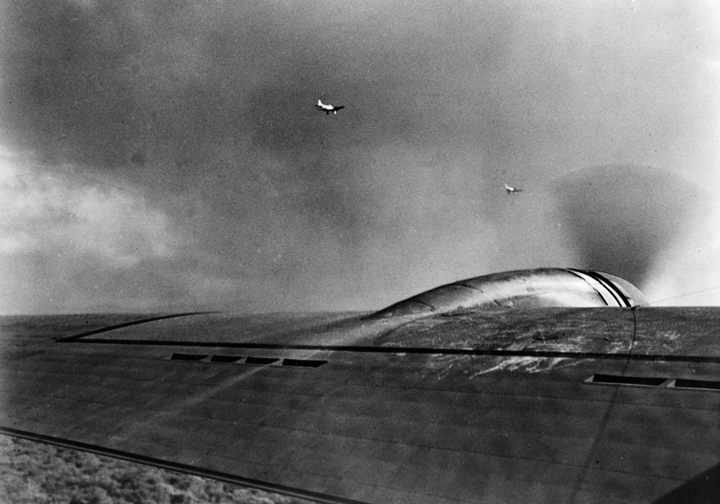
Homelite generators were at the very first American battle of World War
Two! They were in the war from Day One.
Where the B-17s went, so went the Homelite HRU-28, including
the twelve B-17s that arrived at Pearl Harbor on December 7, 1941, during
the Japanese attack.
How cool is the above
photo? Or maybe, how scary was this for the B-17 flight crew?
It was taken by Sgt. Lee Embree in the B-17E
piloted by Lt. Karl T. Barthelmess over Hawaii on December 7, 1941.
Sgt. Embree photographed two Japanese
Aichi D3A “Val” dive bombers on their way to attack American military
installations. Sgt. Embree took this photo from the B-17's port
side waist position. Located not far behind him was a Homelite
HRU-28 auxiliary power unit.
-fortbenning-2018-107w-1.jpg)
The M4 Sherman tank was used not only by the
United States Army and USMC, but American allies as well. The
British, French, and Russians were also equipped with the Sherman via
Lend-Lease. The Sherman tank served around the world and was the
Army's ground units' equivalent of the USAAF's B-17. The 49,234
Sherman tanks that were built were all equipped with a Homelite APU. Author's photo.
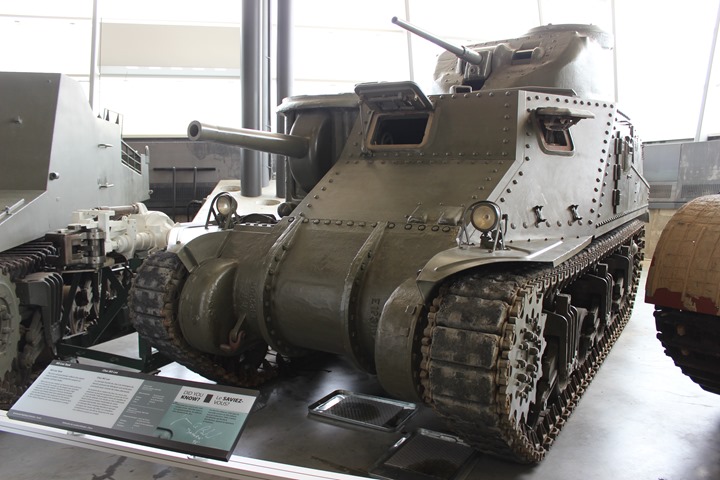
Before the M4 Sherman entered production
American industry produced the M3 Lee/Grant series of tanks. The
M3 series of tanks were the first American medium tanks to see combat
with the U.S. Army in North Africa. However, even before the U.S.
Army landed in North Africa, the British were already using them to
successfully fight German General Erwin Rommel's Desert Forces.
The M3 tanks were equipped with Homelite auxiliary power units. Author's photo.
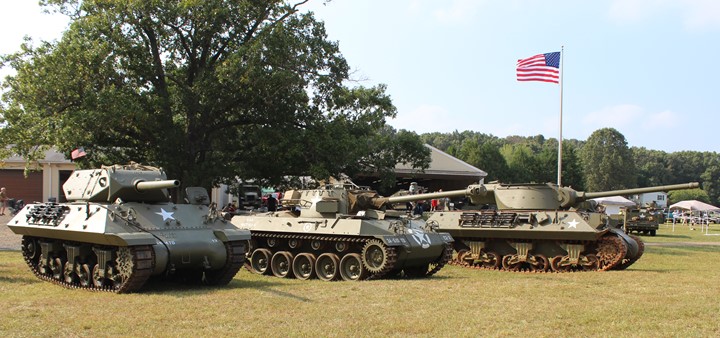
The United States Army also fielded
three types of fully tracked tank destroyers during World War Two.
All came equipped with a Homelite APU. The three types of tank
destroyers are shown on display at the Virginia Museum of Military
Vehicles at Nokesville, VA. On the left is an M10 Wolverine.
In the center is an M18 Hellcat. On the right is an M36. Author's photo.
The Homelite Company
History: In 1921, entrepreneur Charles H. Ferguson of Port
Chester, New York, invented a lightweight, portable, gasoline-powered
electrical generator. His newly founded company, the Home Electric
Lighting Company (later abbreviated to Homelite), made it possible for
thousands of rural farms and households to enjoy the convenience of
electricity, where it would be years before land lines would reach many
of these remote areas. In addition, many of Mr. Ferguson's generators
played a significant role in the war effort, providing portable
electricity on demand for the troops during World War Two.
Although the company is
now known for the quality lawn equipment and chainsaws it manufactures,
it didn’t start that way. The first invention that Ferguson created for
his company was a generator. The generator model that Ferguson invented
was lightweight and portable compared to other options at the time, and
it was gasoline-powered. Although he intended to help provide
electricity to farms and households, his generators played a huge role
in the World War Two war effort by providing portable electricity for
the troops on demand. This was important because electricity was
difficult to obtain on the battlefield, but with the company’s
generators, this was no longer an issue.
The company expanded
just more than a mile away and across the state line to
Greenwich, CT, in 1929, and became a division of Textron Inc. in 1955.
The Gastonia, NC plant opened in 1957 and a sister manufacturing
facility in Greer, SC opened two years later. They moved from Greenwich CT, to a new headquarters in Charlotte, NC in
1975. Beginning in the late 1970s, Homelite gradually expanded its power
equipment line to include string trimmers, leaf blowers, push mowers,
and hedge trimmers. John Deere acquired the brand in 1994.
However, in less than 10 years, John Deere sold Homelite to
Techtronic Industries in 2001, and this is where the company has
remained. Homelite's parent company, Ryobi LTD. Division of Techtronic
Industries, is currently headquartered in Hong Kong.

The Homelite Port Chester, NY plant won the
Army-Navy "E" Award four times during World War Two.
The company received its first award on October 8,1942.
The
Homelite Company's World War Two Production: Table 1 shows
that the Homelite Company produced at a minimum 99,738 auxiliary power
units for use in military aircraft and armored vehicles. The
aircraft and armored vehicles were all part of the spearhead of the
American military's in winning World War Two. Table 3 shows that
the company had 70 major contracts worth $34,525,000 during the war.
The United States Army Air Corps was its biggest customer.
Homelite
Company showed a dramatic increase in employees as the war progressed.
In November 1940, the company had 100 employees. Two years later
at the "E" Award presentation the company had 850 workers. With
the end of the war in August 1945, 1,000 workers were laid off with the
cancellation of military contracts. Homelite had to have had
an excellent management team to be able absorb the tenfold increase in
workers to meet the military's insatiable demand for auxiliary power
units.
|
Table 1 - Homelite Company's World War Two Auxiliary Power
Plant Production by Application |
|
Application |
Number Built |
Homelite Auxiliary Power Unit |
|
Aircraft |
|
|
|
B-17 |
12,731 |
HRU-28/HRU-28A |
|
B-24 |
18,188 |
HRU-28/HRU-28A |
|
PB4Y-2 |
736 |
HRU-28/HRU-28A |
|
C-46 |
3,181 |
HRU-28/HRU-28A |
|
Total Aircraft |
34,836 |
|
| |
|
|
|
Armored Vehicles |
|
|
|
M3 Medium Tank |
6,258 |
HRH-28/HRUH-28 |
|
M4 Medium Tank |
49,234 |
HRH-28/HRUH-28 |
|
M10 Tank Destroyer |
4,993 |
HRH-28/HRUH-28 |
|
M10A1 Tank Destroyer |
1,413 |
HRH-28/HRUH-28 |
| M18
Tank Destroyer |
2,507 |
HRH-28/HRUH-28 |
|
M36 Tank Destroyer |
487 |
HRH-28/HRUH-28 |
|
Total Armored Vehicles |
64,892 |
|
|
Grand Total |
99,728 |
|
|
Table 2 - Homelite Company's
Major World War Two Contracts - Greenwich, CT Plant
The information below
comes from the "Alphabetical Listing of Major War Supply
Contracts, June 1940 through September 1945." This was
published by the Civilian Production Administration, Industrial
Statistics Division, Requirements and Progress Branch January
21, 1946. |
|
Product |
Contract Amount |
Contract Awarded
|
Completion
Date |
| Tank Parts - Army
Ordnance |
$107,000 |
7-1943 |
3-1944 |
| Power Plant Parts
- Navy |
$134,000 |
11-1943 |
7-1944 |
| Elec Generators
HRUH - Army Ordnance |
$61,000 |
1-1945 |
8-1945 |
| Engine Cylinders
- USAAF |
$79,000 |
1-1945 |
5-1945 |
| Engine Cylinders
- USAAF |
$88,000 |
2-1945 |
6-1945 |
| Cylinder Piston
Assys - USAAF |
$199,000 |
3-1945 |
10-1945 |
| Power Plant Parts
- USAAF |
$151,000 |
3-1945 |
11-1945 |
| Elec Generators -
Army Ordnance |
$62,000 |
4-1945 |
10-1945 |
| Power Plant
Equipment - USAAF |
$331,000 |
5-1945 |
12-1946 |
| Power Plant
Equipment - USAAF |
$110,000 |
5-1945 |
2-1946 |
| Power Plant
Equipment - USAAF |
$322,000 |
6-1945 |
2-1946 |
| Power Plant
Equipment - USAAF |
$411,000 |
6-1945 |
1-1946 |
| Total |
$2,055,000 |
|
|
|
Table 3 - Homelite Company's Major World War Two Contracts -
Port Chester, NY Plant
The information below comes from the "Alphabetical
Listing of Major War Supply Contracts, June 1940 through
September 1945." This was published by the Civilian
Production Administration, Industrial Statistics Division,
Requirements and Progress Branch January 21, 1946.
|
|
Product |
Contract Amount |
Contract Awarded
|
Completion
Date |
|
Plant Electric
Power - USAAF |
$165,000 |
10-1940 |
4-1941 |
| Power Units -
Army Signal Corps |
$550,000 |
11-1940 |
11-1941 |
| Generators - Army
Ordnance |
$61,000 |
1-1941 |
5-1941 |
| Generators - Army
Ordnance |
$81,000 |
6-1941 |
1-1942 |
| Generators -
USAAF |
$5,635,000 |
8-1941 |
4-1943 |
| Electrical
Equipment - USAAF |
$1,350,000 |
9-1941 |
4-1943 |
| Blowers - USAAF |
$106,000 |
1-1942 |
5-1942 |
| Generator Parts -
USAAF |
$236,000 |
7-1942 |
4-1943 |
| Blowers - Army
Engineering Corps |
$114,000 |
7-1942 |
1-1943 |
| Generators - Army
Ordnance |
$88,000 |
8-1942 |
4-1943 |
| Plants Power -
USAAF |
$88,000 |
9-1942 |
11-1942 |
| Generators - Army
Ordnance |
$150,000 |
9-1942 |
7-1943 |
| Engines Gasoline
- Army Ordnance |
$1,626,000 |
10-1942 |
10-1943 |
| Power Plants -
USAAF |
$523,000 |
10-1942 |
11-1942 |
| Blowers - Army
Engineering Corps |
$110,000 |
10-1942 |
6-1943 |
| Generators - Army
Ordnance |
$454,000 |
10-1942 |
1-1943 |
| Engines Gasoline
- USAAF |
$1,346,000 |
11-1942 |
6-1943 |
| Power Units -
USAAF |
$148,000 |
12-1942 |
8-1943 |
| Power Plants -
USAAF |
$132,000 |
12-1942 |
8-1943 |
| Power Plants -
USAAF |
$2,376,000 |
12-1942 |
2-1944 |
| Tank Generators
- Army Ordnance |
$80,000 |
2-1943 |
7-1943 |
| Generators - Army
Ordnance |
$222,000 |
2-1943 |
5-1943 |
| Power Plants -
USAAF |
$3,255,000 |
2-1943 |
2-1944 |
| Generators - Army
Ordnance |
$479,000 |
5-1943 |
4-1944 |
| Generators - Army
Engineering Corps |
$54,000 |
5-1943 |
10-1943 |
| Portable Power
Plants - Army Engineering Corps |
$136,000 |
6-1943 |
5-1944 |
| Power Units -
Army Signal Corps |
$2,687,000 |
6-1943 |
10-1945 |
| Tank Parts
- Army Ordnance |
$107,000 |
7-1943 |
2-1944 |
| Electric
Generators - Army Ordnance |
$51,000 |
8-1943 |
10-1943 |
| Electric
Generators - Navy |
$68,000 |
8-1943 |
10-1943 |
| Electric
Generators - Navy |
$70,000 |
8-1943 |
11-1943 |
| Generators
- Navy |
$110,000 |
9-1943 |
1-1944 |
| Power Plant Parts
- USAAF |
$87,000 |
10-1943 |
4-1944 |
| Power Plant Parts
- USAAF |
$56,000 |
10-1943 |
5-1944 |
| Generator Sets -
Army Engineering Corps |
$254,000 |
11-1943 |
10-1944 |
| Power Plant Parts
- USAAF |
$167,000 |
11-1943 |
6-1944 |
| Electric Power
Plants - Navy |
$158,000 |
12-1943 |
11-1944 |
| Electric Power
Plants - Navy |
$82,000 |
12-1943 |
4-1944 |
| Professional
Services - USAAF |
$71,000 |
12-1943 |
12-1944 |
| Portable
Generators - Navy |
$97,000 |
1-1944 |
7-1944 |
| Auxiliary Power
Plants - Navy |
$138,000 |
1-1944 |
9-1944 |
| Electric Power
Plants - USAAF |
$178,000 |
1-1944 |
12-1944 |
| Generator Sets -
Army Engineering Corps |
$57,000 |
4-1944 |
5-1945 |
| Motor Generators
PU33 - Army Signal Corps |
$186,000 |
6-1944 |
2-1945 |
| Motor Generators
- Army Signal Corps |
$139,000 |
6-1944 |
8-1945 |
| Auxiliary Power
Units - Navy |
$323,000 |
10-1944 |
9-1945 |
| Elec Generator
Sets - Army Engineering Corps |
$1,200,000 |
10-1944 |
5-1945 |
| Electric Power
Plants - USAAF |
$585,000 |
10-1944 |
3-1945 |
| Power Plant Parts
- USAAF |
$252,000 |
11-1944 |
10-1945 |
| Power Units PU6 -
Army Signal Corps |
$287,000 |
12-1944 |
12-1945 |
| Electric Power
Units - Navy |
$341,000 |
1-1945 |
9-1945 |
| Elec Generator
Sets - Army Engineering Corps |
$688,000 |
2-1945 |
2-1946 |
| Electric
Generators - Navy |
$1,355,000 |
4-1945 |
12-1945 |
| Motor Generators
- Army Signal Corps |
$345,000 |
4-1945 |
12-1945 |
| Power Plant Assys
- USAAF |
$2,291,000 |
4-1945 |
5-1946 |
| Power Unit Parts
- Navy |
$27,000 |
5-1945 |
1-1946 |
| Power Unit Parts
- Navy |
$135,000 |
6-1945 |
2-1946 |
| Power Units PU6 -
Army Signal Corps |
$163,000 |
6-1945 |
12-1945 |
| Total |
$32,470,000 |
|
|
|
Table 4 - Homelite Company's
Major World War Two Contracts by Customer Both Plants |
|
Customer |
Contract Value |
Number of Contracts |
Percentage |
| USAAF |
$20,738,000 |
28 |
60% |
| Army Signal Corps |
$4,357,000 |
7 |
12.6% |
| Army Ordnance |
$3,629,000 |
14 |
10.5% |
| Navy |
$3,038,000 |
13 |
7.9% |
| Army Engineering
Corps |
$2,613,000 |
8 |
7.6% |
| Total |
$34,525,000 |
70 |
~100% |
The Homelite auxiliary
power unit has been overlooked by historians and military book authors
in its contribution to winning World War Two. An examination of several
books on the B-17, B-24, and the Sherman tank will not find any mention
of the Homelite HRU-28 nor the HRH-28. There are all sorts of
information on types of weapons, engines, and changes to the weapons as
the war progressed. But there is not any reference to the Homelite
auxiliary power units. This is a vast oversight by the authors of
these books, as the auxiliary power units were essential components of
these weapons. For the bombers and cargo aircraft, the APUs
provided starting power to save the batteries. They could also be
used as emergency backup power at low attitudes to supply power if an engine
generator failed. For the armored vehicles, they also could be
used to start the vehicle, especially when it was cold. The APU
supplied power to the armored vehicle in lieu of the main engine as a
way to save
fuel. When the armored vehicles were not moving the APU supplied
power to keep the radios and other equipment running. Homelite
auxiliary power units were important to the crews of the American
bombers, cargo aircraft, medium tanks, and fully tracked tank
destroyers.
HRU-28A for B-24, C-46 and B-17 Walk Around:
The unit shown below is the only one I have found in my ten years of
investigating how American companies helped win World War Two.
This unit was on display at the 2023 TBM Reunion/Salute to Veterans at
the Peru, IL airport. The discovery of this APU then prompted me to
write this page on the Homelite Company.
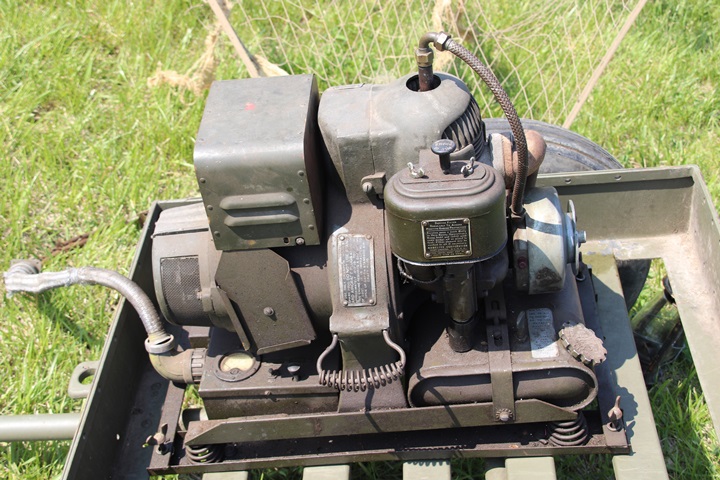
Author's photo.
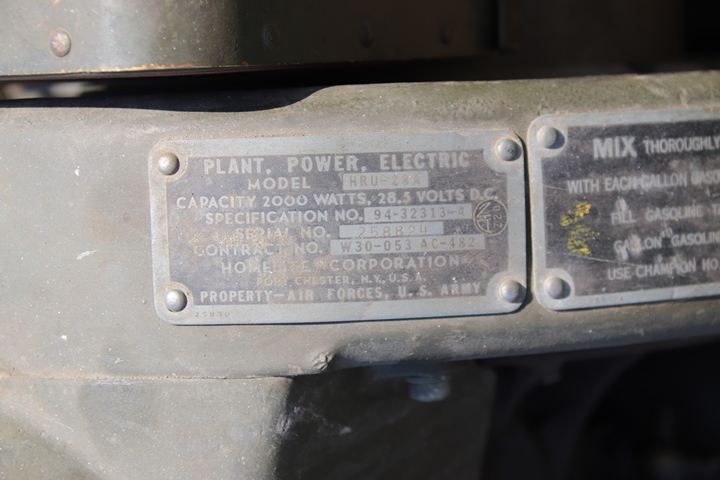
This Model HRU-28A is serial number 258824.
Author's photo.
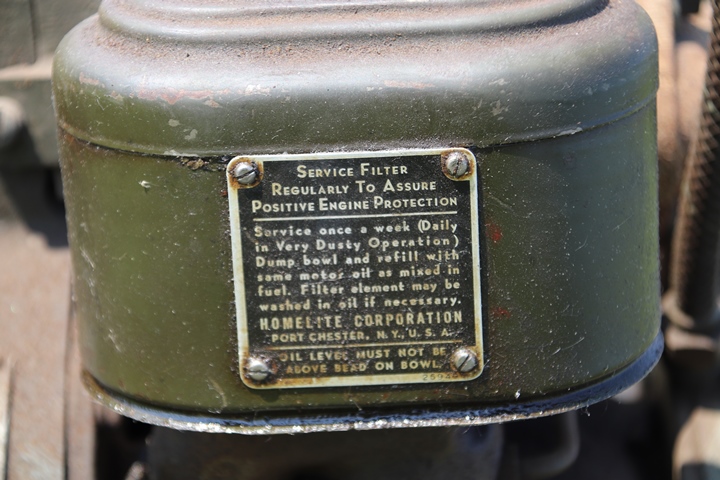
Author's photo.
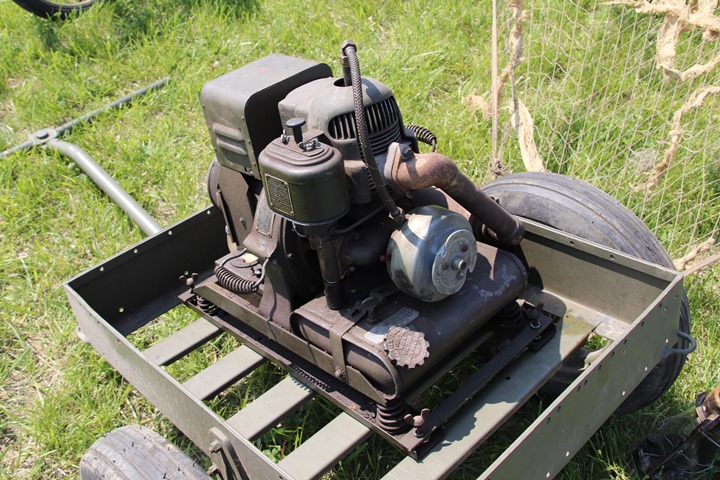
Author's photo.
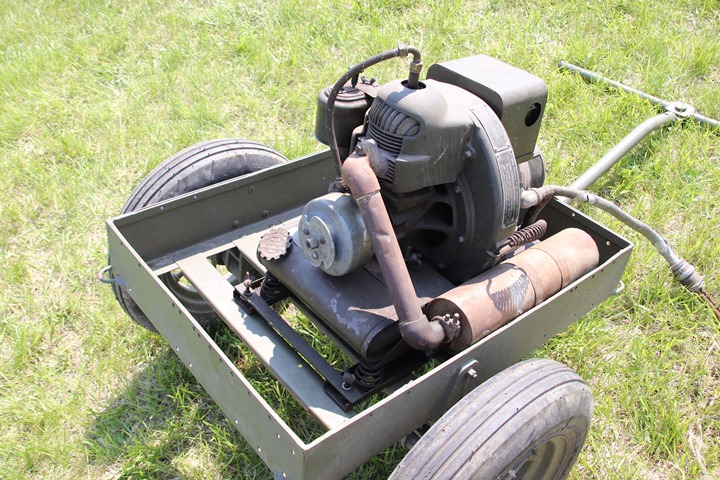
Author's photo.
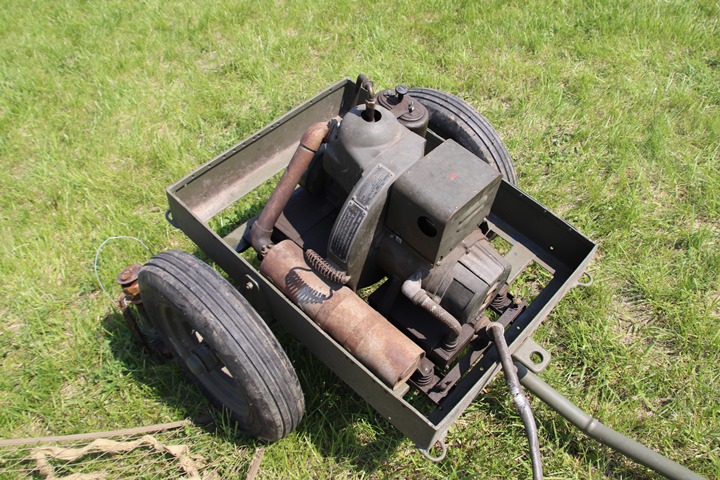
Author's photo.
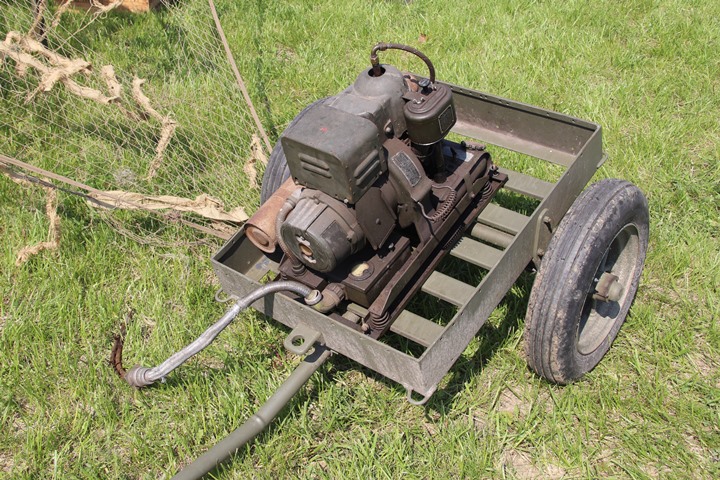
Author's photo.
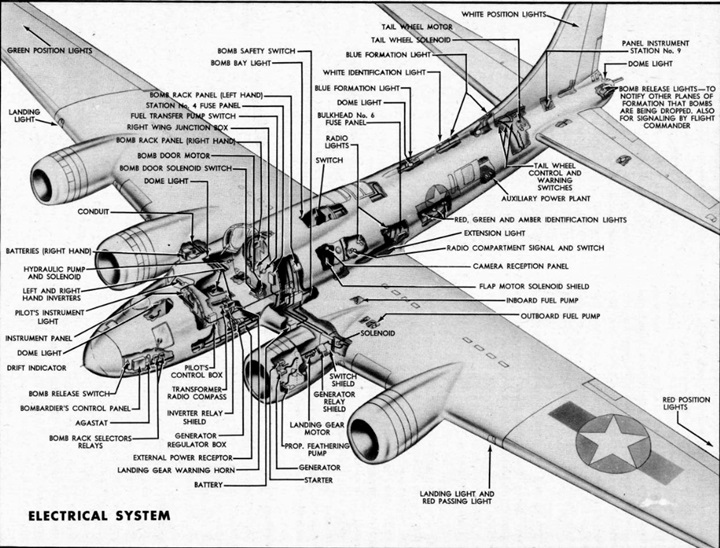
This image from a B-17 pilot training manual
shows the location of the auxiliary power plant being located in rear
port side of the fuselage near the tail section.
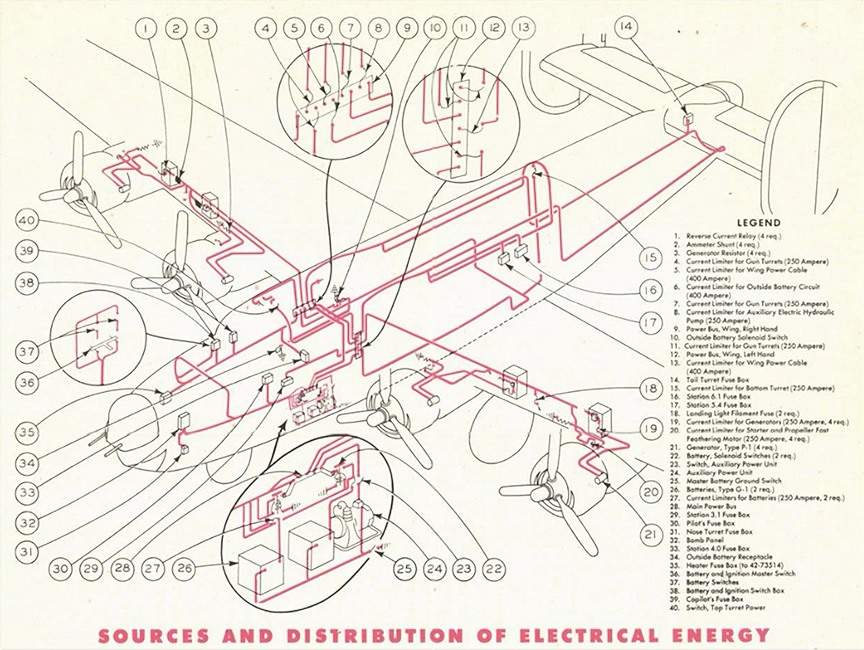
On the B-24, the Homelite HRU-28 was located
under the flight deck. It is item number 24 on this drawing taken
from the pilot training manual for the B-24.
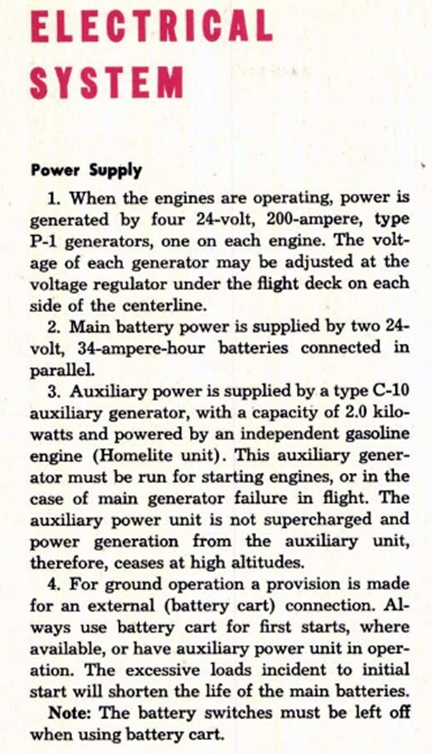
From the pilot training manual for the B-24.
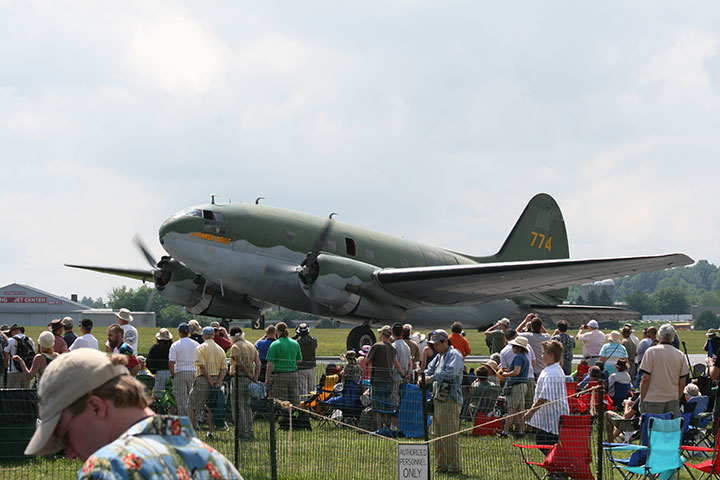
The Curtiss C-46 Commando was the largest
twin engine transport used by the US in World War Two and used a
Homelite HRU-28 APU. Author's Photo.
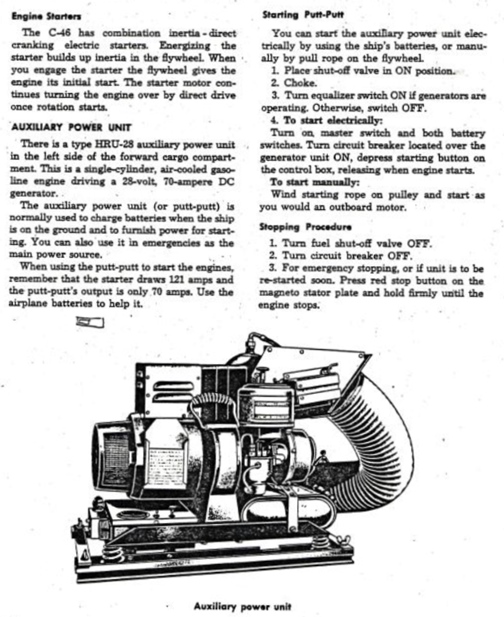
From pilot training manual for the
C-46.
M3 Medium Tanks:
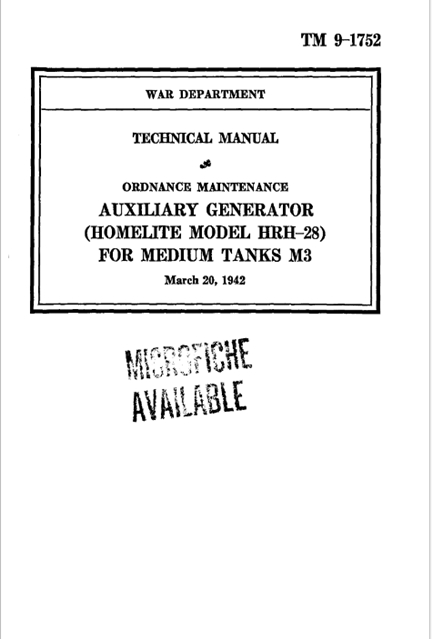
Not all technical manuals from World War Two
still exist. I was able to find the TM 9-1752 for the auxiliary
generator for the M3 medium tank. This and the next five pages are from
that manual. Note that the title page specifically names the Homelite HRH-28 as the specified unit.
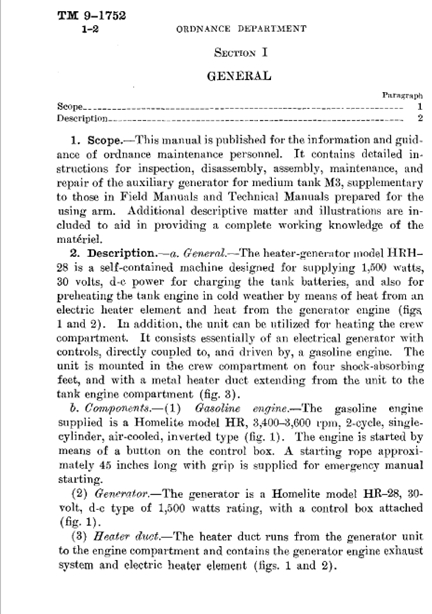
Paragraph 2a describes all of the functions
the Homelite HRH-28 performed in the M3 medium tank. These
included charging the batteries, pre-heating the engine, and heating the
crew compartment. It was a very important piece of equipment in
the M3 tank.
I was not able to find any auxiliary
generator manuals for the M4 Sherman series of tanks nor for the
M10/M10A, M18, and M36 tank destroyers. However, the manuals would
have been very similar to the one shown here. The Homelite HRH-28
served the same functions in these armored vehicles as in the M3 medium
tank.
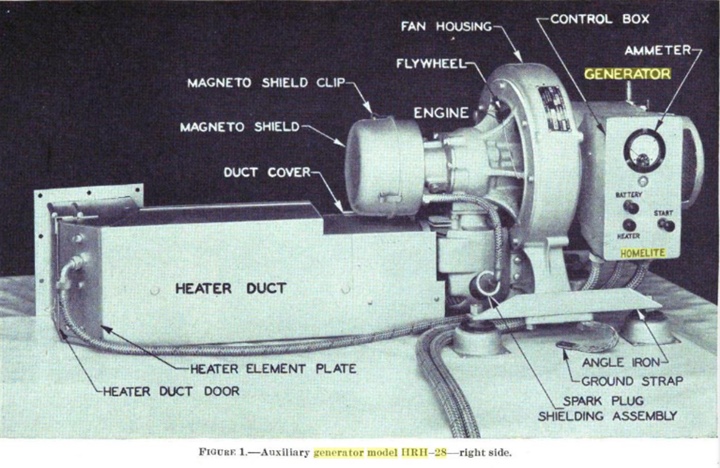
The name "Homelite" is visible on this
generator in the manual
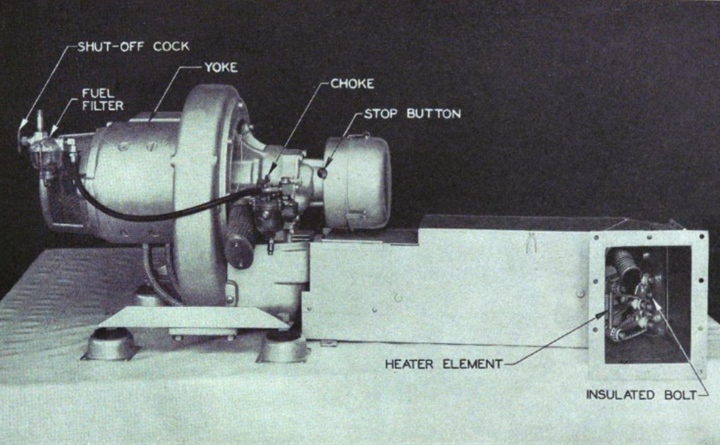
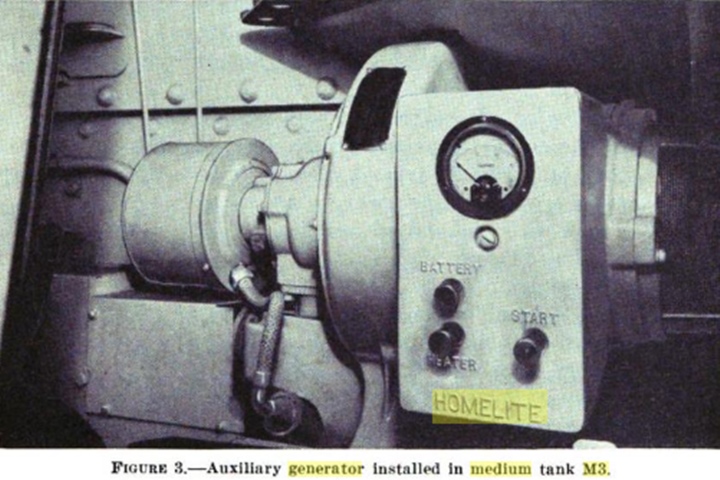
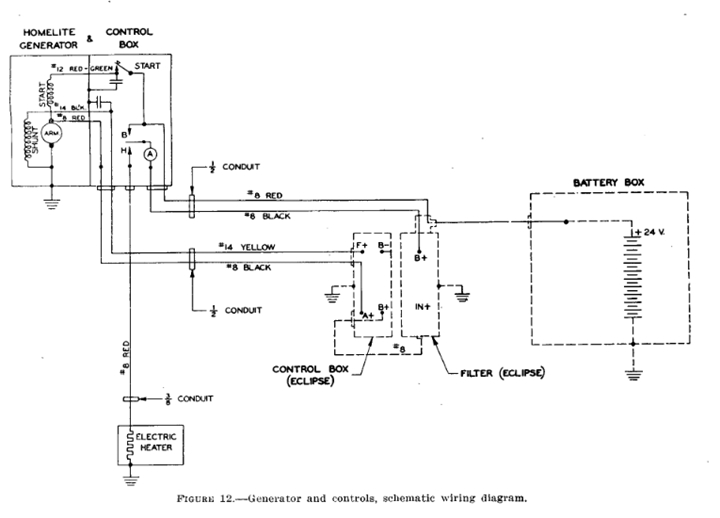
|
Table 5 - M3
Type Medium Tanks with Homelite HRH-28 Auxiliary Generator |
|
Manufacturer |
Type |
Number Built |
| American
Locomotive Company (ALCO) |
M3 |
385 |
| Baldwin
Locomotive Works |
M3 |
295 |
| Chrysler
(Detroit Tank Arsenal) |
M3 |
3,243 |
| Pressed Steel
Company |
M3 |
501 |
| Pullman |
M3 |
500 |
| Total M3
Medium Tanks |
|
4,924 |
| |
|
|
| American
Locomotive Company (ALCO) |
M3A1 |
300 |
| Baldwin
Locomotive Works |
M3A2 |
12 |
| Baldwin
Locomotive Works |
M3A3 |
322 |
| Chrysler
(Detroit Tank Arsenal) |
M3A4 |
109 |
| Baldwin
Locomotive Works |
M3A5 |
591 |
| Grand
Total All M3 Type Medium Tanks |
|
6,258 |
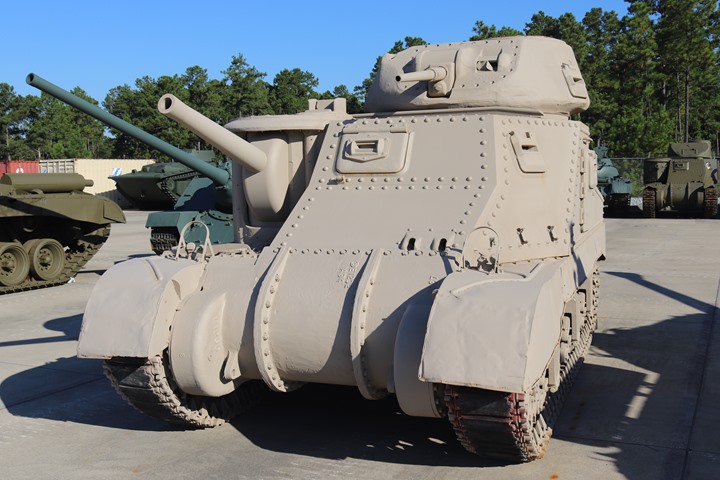
This is M3 Lee tank Serial Number 1054 with a Grant turret.
It was built by Baldwin in November 1941.
Author's photo from the U.S. Army Armor and Cavalry Collection, Fort Benning, GA.
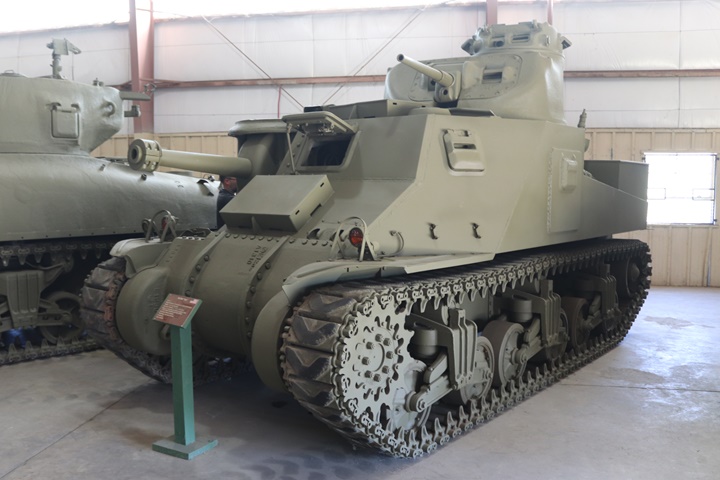
This M3A3 Lee Serial Number 1099 was manufactured by Baldwin in May 1942. Author's photo from
the U.S. Army Armor and Cavalry Collection at Fort Benning, GA.
M4 Series Sherman Tanks:
There were 49,234 Sherman tanks built during World War Two in six
different main categories depending on the engine type. Homelite
produced the HRH-28 or HRUH-28 auxiliary power plants for the
49,234 Sherman tanks.
|
Table 6 - M4 Series Medium Tanks with Homelite HRH-28
Auxliary Generator |
|
Type |
Number Built |
Manufacturers |
Engine Type |
|
M4 |
8,389 |
Alco, Baldwin, Chrysler, Pressed Steel Company, Pullman
Standard |
Continental R-975 Radial - Welded Hull |
|
M4A1 |
9,707 |
Lima Locomotive, Pacific Car and Foundry, Pressed Steel
Company |
Continental R-975 Radial - Cast Hull |
|
M4A2 |
10,968 |
Alco, Baldwin, Federal Machine, Fisher Body, Pressed Steel
Company, Pullman Standard |
Detroit Diesel 6-71 Diesel |
|
M4A3 |
12,596 |
Chrysler, Ford, Fisher Body |
Ford Motor Company GAA V-8 |
|
M4A4 |
7,499 |
Chrysler |
Chrysler A57 Multibank |
|
M4A6 |
75 |
Chrysler |
Caterpillar RD-1820 Radial Diesel |
|
Total |
49,234 |
|
|
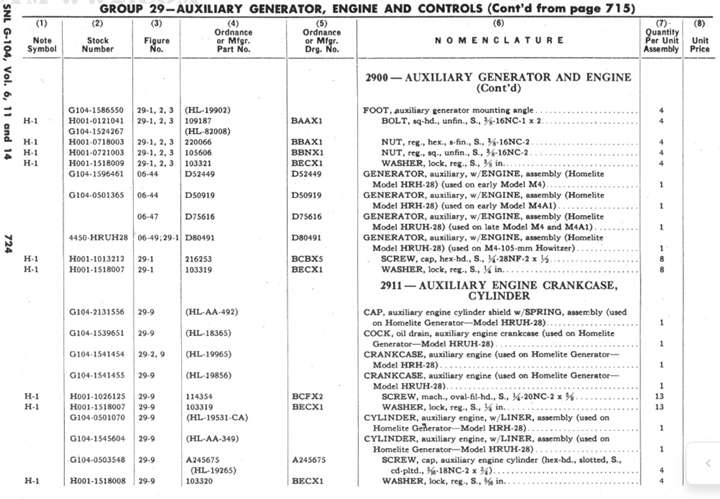
While I was not able to find the technical
manuals for the auxiliary generator used in the M4 series of medium
tanks, I was able to find the parts manual for the M4/M4A1 that specify
Homelite generators. Note that the HRH-28 was used on early models
of the M4 and M4A1 and the HRUH-28 on later models.
-crestviewfl-sn1765-2022-107w-1.jpg)
This Alco-built M4E9(75) is on display in
front of the Am Vets 35 in Crestview, FL. This is serial number
1765 and was built in April 1943. It is the oldest surviving Alco
M4 and is typical of all models of the early M4 Sherman series tank.
Author's photo.
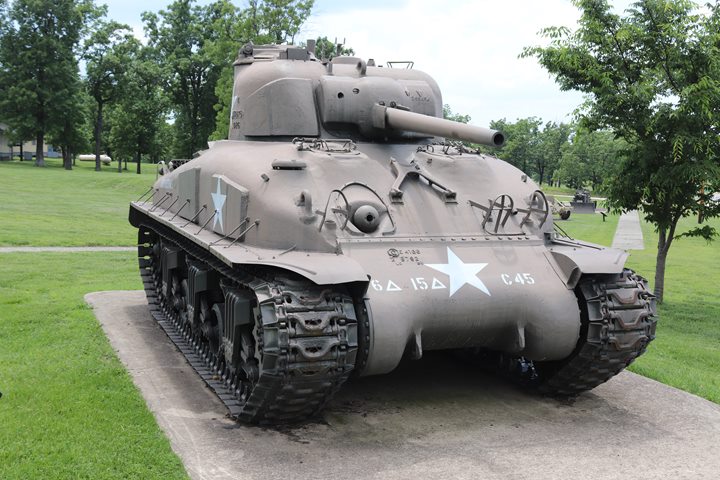
Pacific Car and Foundry built 926
M4A1(75)
VVSS Sherman tanks like this one on display at the Fort Leonard Wood, MO
Museum outside tank park. It is the only one in the United States,
and one of six remaining in the world. Production of the M4A1
started in May 1942 and finished in November 1943. The main
difference between this M4A1 and the M4 above is that the M4A1 has a
cast hull. Author's photo.
M4 Series Tanks Operator's Manuals:
For the M4A2 and M4A4, I was able to find these manuals. The
photos below show the same photos as the ones above for the
M4/M4A1.
M4A2 Sherman Tank:
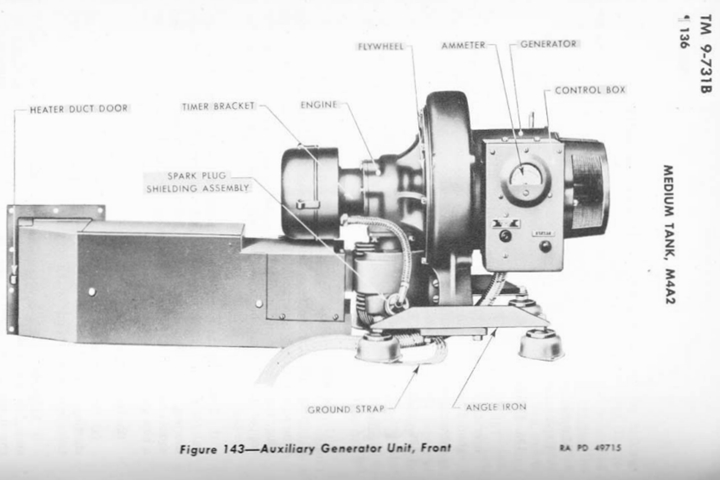
The name "Homelite" appears to no long be on
the control box. As the war progressed, manufacturers were no
longer allowed to put their names on the product.
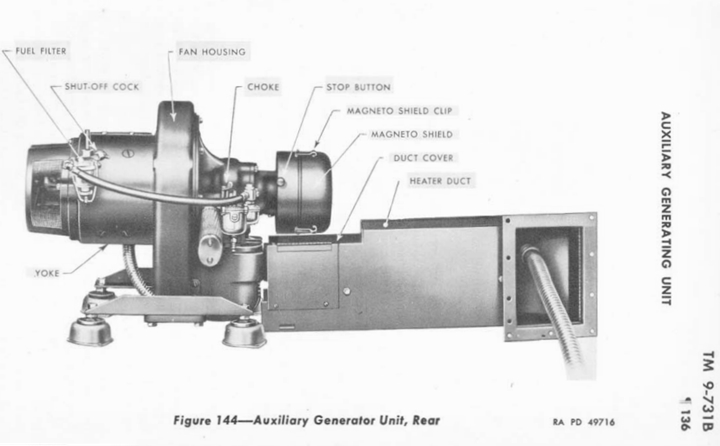
M4A4 Sherman Tank:
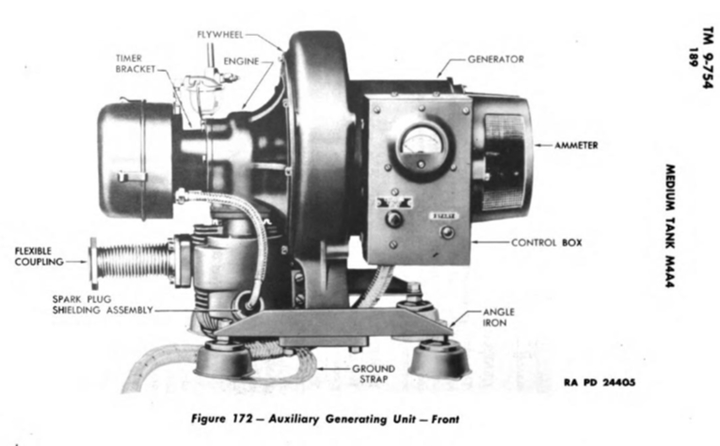
In this manual, the heat duct is no
longer shown, only the generator.
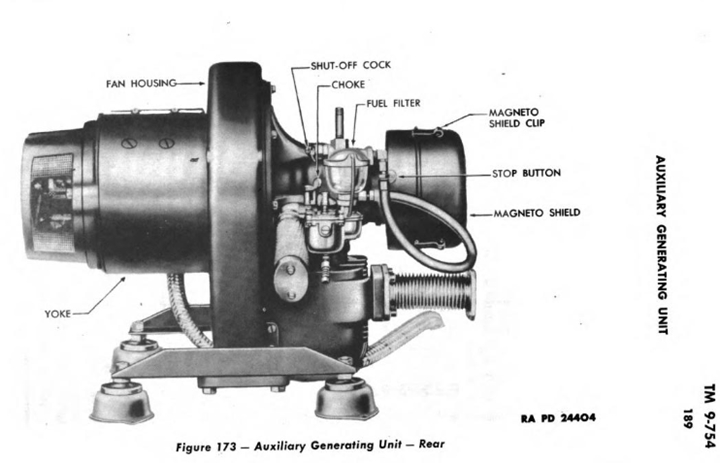
Tank Destroyers:
M10 Hellcat Tank Destroyer:
I was able to find both the technical and supplier manuals for the
M18 Hellcat tank destroyer.
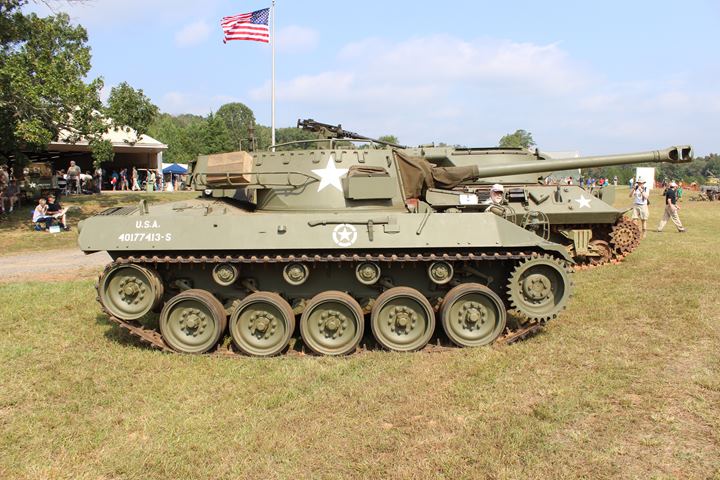
Author's photo.
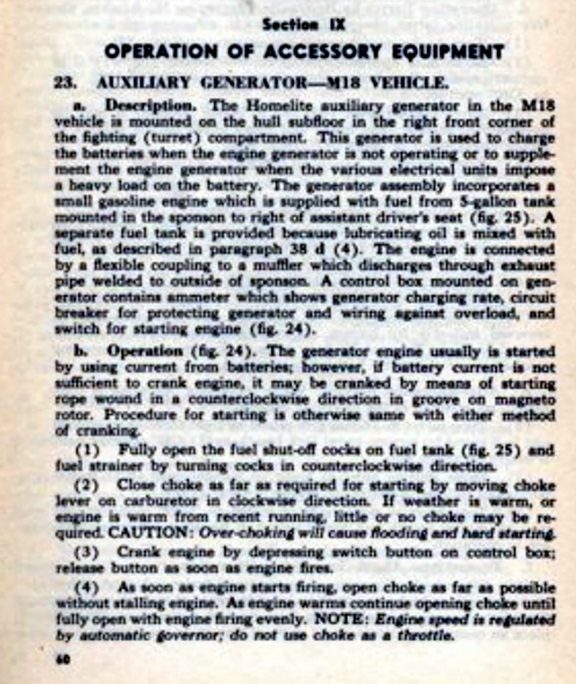
While Technical Manual TM 9-755 does not
specify the model number, it does show that the APU is a Homelite.
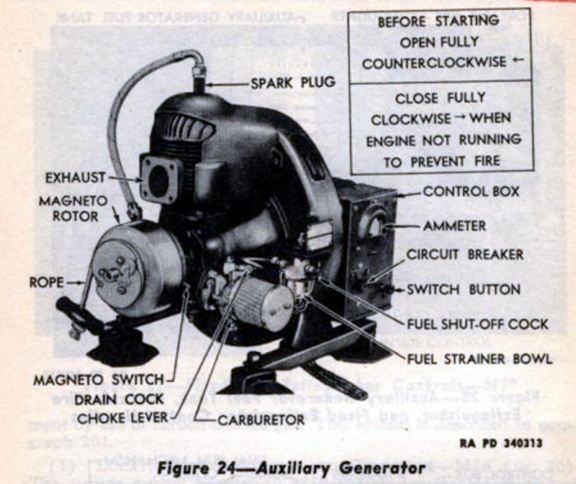
This image from TM 9-755 shows a Homelite
HRH-28 series APU.
M10 Tank Destroyer: The M10 was
built on the same chassis and with the same engine as the M4A2 Sherman
tank. The Homelite APU was universal across this product line.
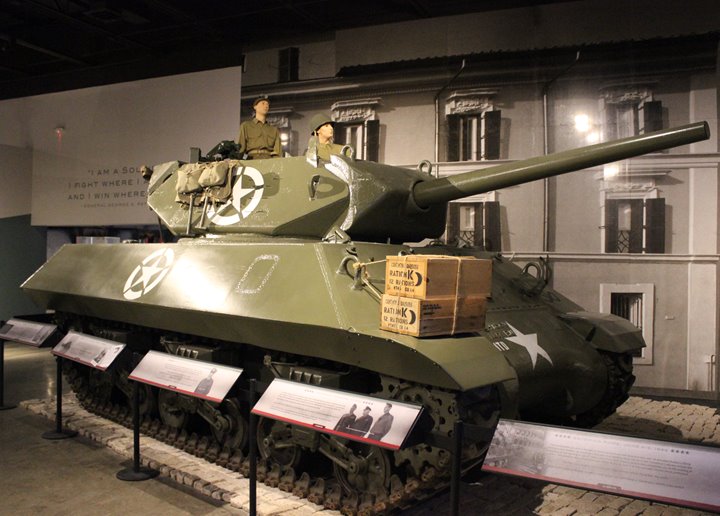
This M10 is on display at the Patton Museum
at Fort Knox. Author's photo.
M36 Tank Destroyer: The M36 was a
conversion from M10A1 type tank destroyers which were built on the same
chassis and engine as the M4A3 Sherman tanks. The original 75mm
main guns and turrets were replaced with a new turret and 90mm main gun.
The hull with the existing Homelite generator remained the same.
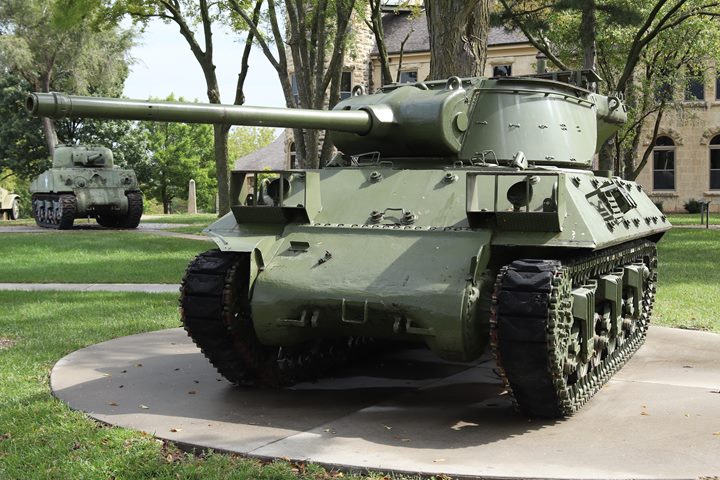
This M36 is on display at the U.S. Cavalry
Museum, Fort Riley, KS, and was converted from a Ford-built M10A1.
In the background is an M4A3 Sherman tank. Author's photo.
U.S. Army Signal Corps Power Units:
Homelite also built other types of portable generators for the U.S.
Army Signal Corps.
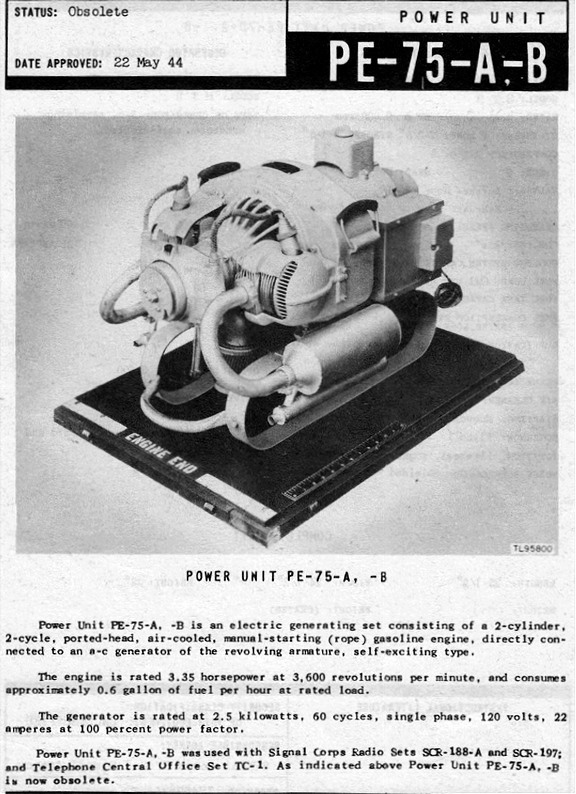
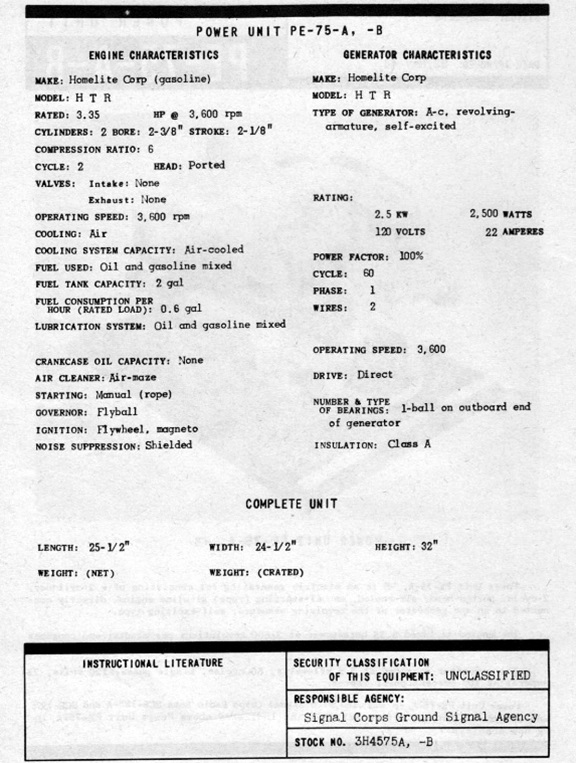
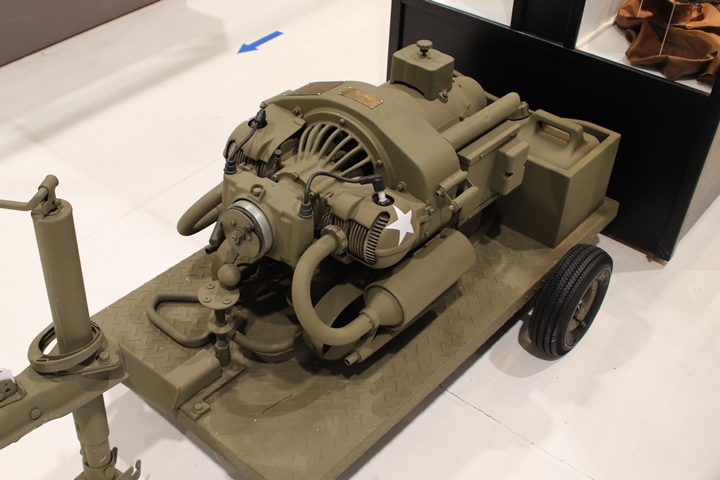
The Evansville Wartime Museum in Evansville,
IN has what appears to be the non-military model HTR version of the PE-75 on
display. It has been painted. Author's photo.
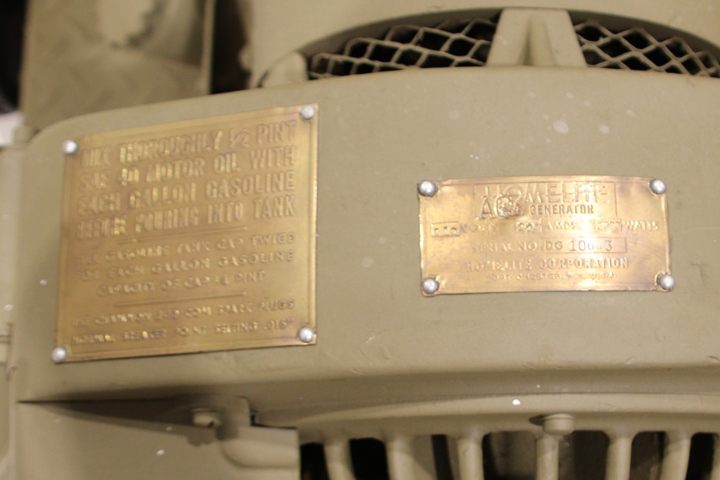
The brass tags are non-military. These
are too shiny for military use. The data plate does not show a
contract number, specification, nor note that it is property of the U.S.
Signal Corps. Otherwise, military PE-75s would be just like this
civilian version. Author's photo.
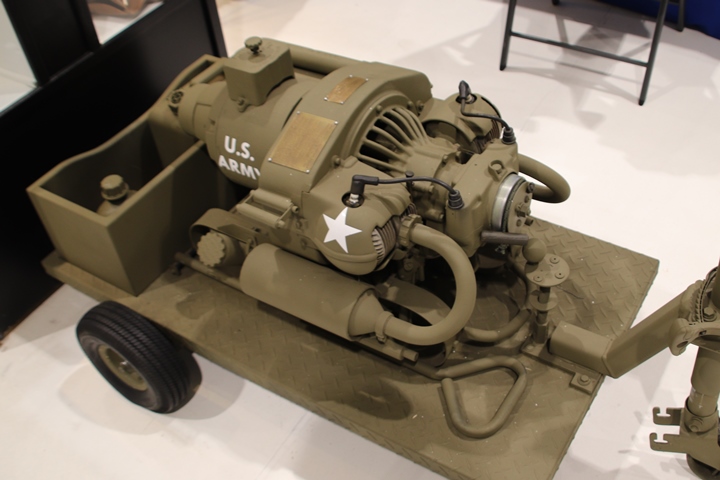
Author's photo.

Author's photo.
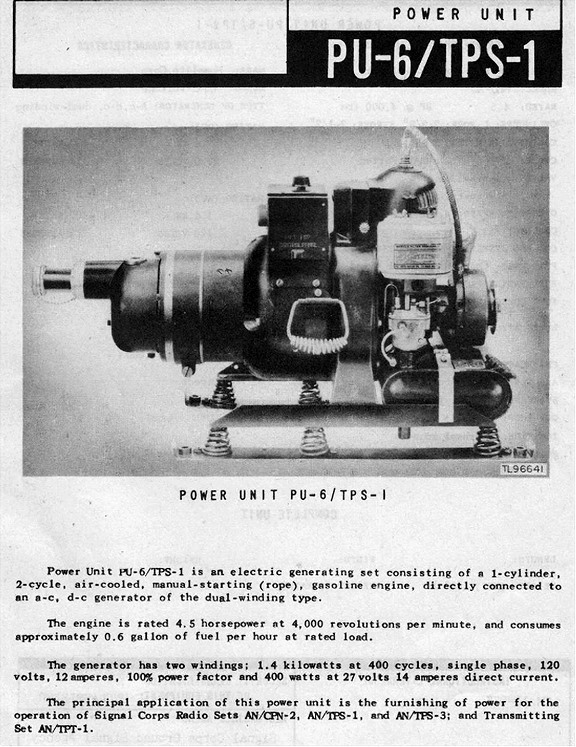
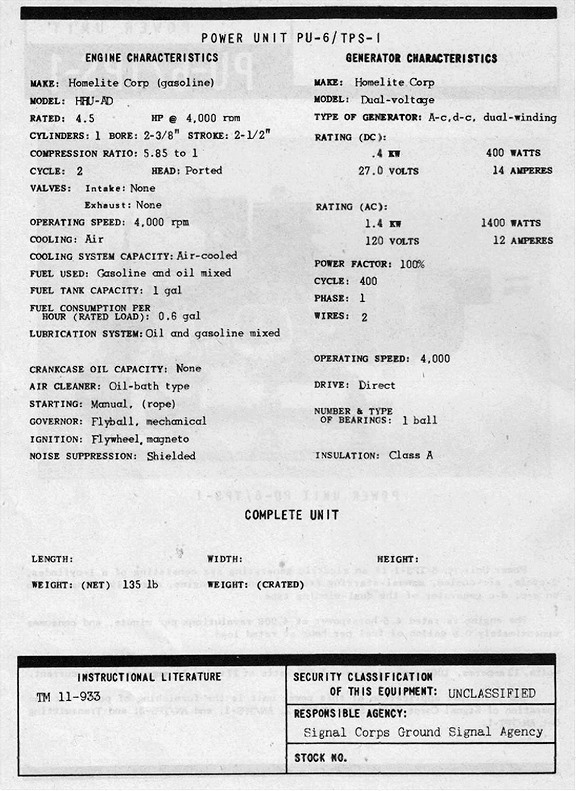
The Bottom Line: The Homelite
Company and its HRH-28 and HRU-28 series of auxiliary power units have
not been given the credit they deserve in helping to win World War Two.
By being used in all B-17s, B-24s, and C-46s the Homelite APUs served on
many of the most famous and important aerial missions around the world.
The same can be said for the Homelite APUs that were important equipment
in the M3 and M4 series of medium tanks and the M10/M10A1, M18, and M36
tank destroyers. These weapons also served around the globe during
World War Two.
The Homelite Company was an important piece of
each of these types of equipment, as they helped U.S. military push back the forces of
tyranny and made the world safe for democracy.
|


-fortbenning-2018-107w-1.jpg)
























-crestviewfl-sn1765-2022-107w-1.jpg)

















